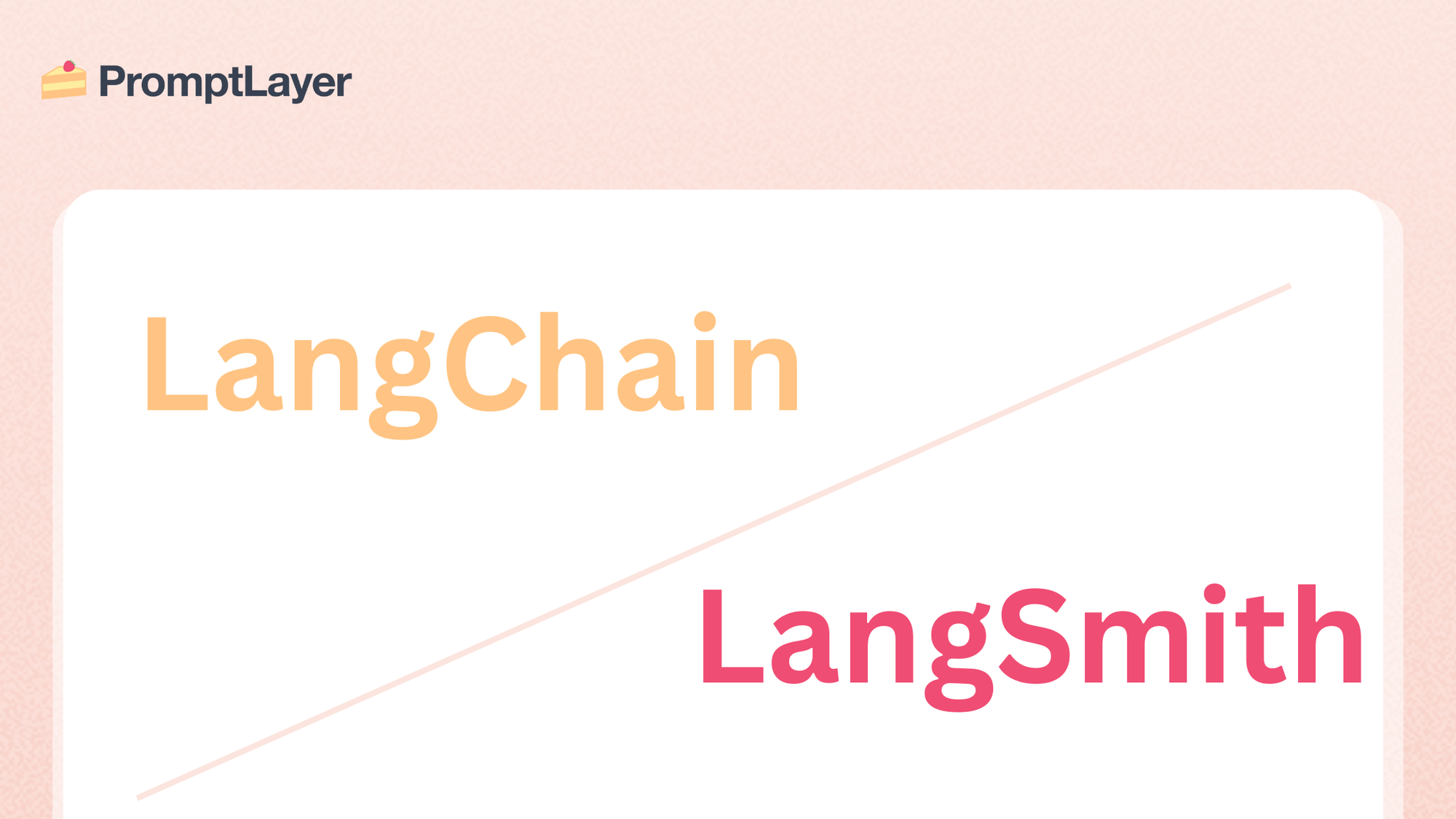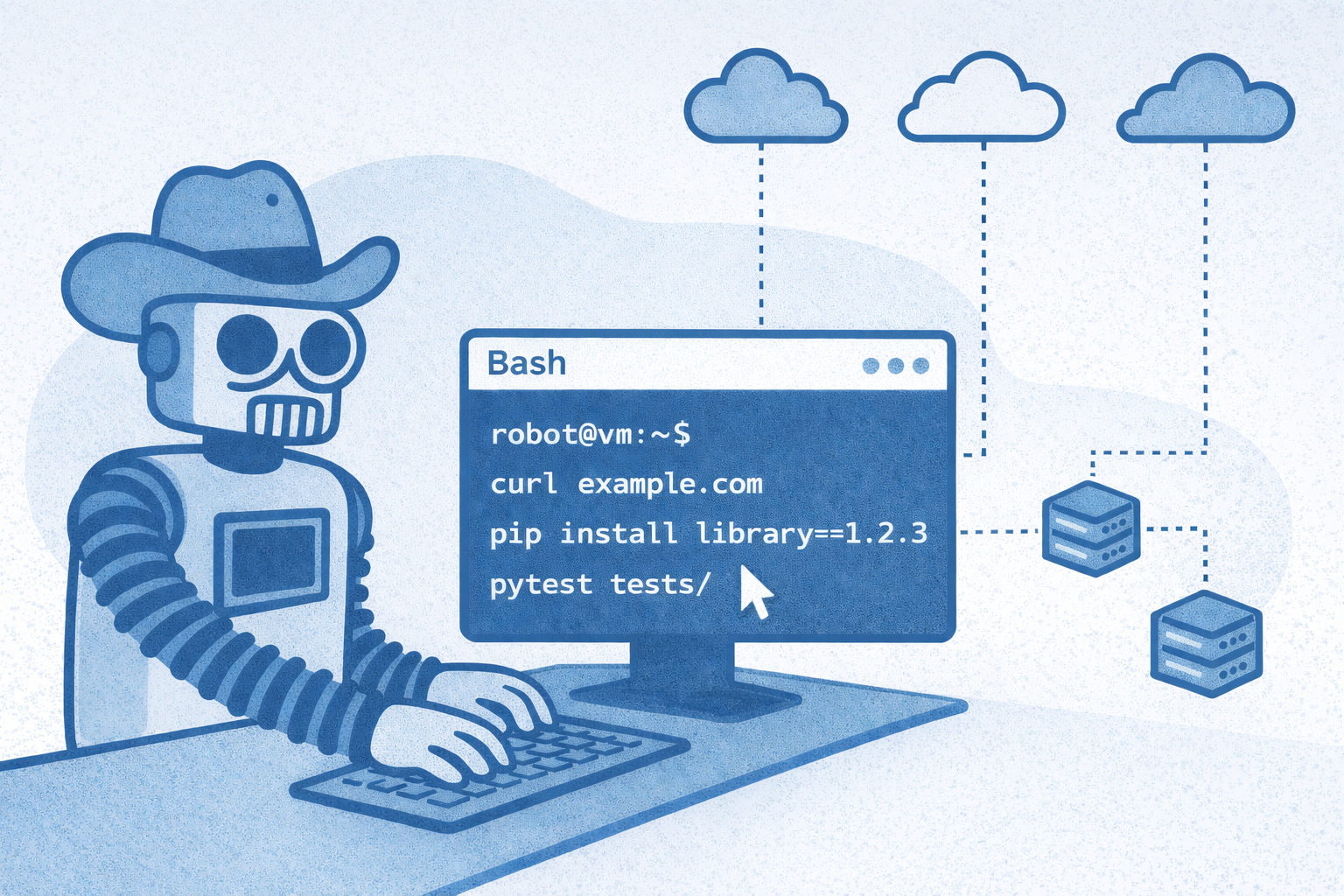LangChain vs LangSmith: A Developer-Focused Comparison

In LLM application development, LangChain and LangSmith have become central tools for building and managing large language model-powered solutions. This article compares LangChain and LangSmith, focusing on their core features, integration options, and value for developers in the LLM application space.
LangChain
Overview:
LangChain is an open-source framework that helps developers create LLM applications efficiently. Since its launch in 2022, LangChain has built a large and active community. LangChain aims to simplify AI workflows. It does so by standardizing model interfaces and offering a rich library of modular components. With LangChain, developers can quickly build chatbots, agents, and other AI applications with minimal boilerplate code.
Supercharge Your Prompt Engineering with PromptLayer
PromptLayer offers a powerful suite of tools designed for both developers and non-technical team members, making it easy to organize, test, and deploy prompts with confidence.
Instantly access version control, batch evaluations, A/B testing, and detailed analytics—all from an intuitive dashboard that integrates seamlessly with platforms like OpenAI and LangChain.
Whether you’re refining prompts for a production system or collaborating across teams, PromptLayer’s modular architecture and synthetic evaluation tools help you iterate faster and ensure quality at every stage.
Experience the ease of a dedicated prompt CMS, keep your workflow agile, and ship better LLM solutions in record time.
Key Features and Functionality:
LangChain is built for composability and seamless integration. Its primary features include:
- Chains and Sequencing:
Developers can connect multiple LLM calls and tools into step-by-step workflows. One model’s output becomes the input for another, making it easy to build complex processes. LangChain provides built-in types for common tasks like question answering or summarization, while supporting custom workflows as needed. - Prompt Templates and Memory:
LangChain offers utilities for prompt engineering, such as templates with placeholders and modules for managing conversational context. These features help maintain context across interactions, making it easier to build applications that remember prior conversations. - Tools and Agents:
Out-of-the-box, LangChain supports "agentic behavior," meaning it lets LLMs decide which external tool to use next. The agent framework enables LLM-powered applications to reason and act, choosing actions like calculator use or web search during a conversation. Developers can register custom tools, expanding what their agents can do. (Agentic behavior refers to an AI's ability to make decisions and select tools to accomplish tasks.) - Integration with External Data:
LangChain includes connectors for external data and APIs. It can ingest documents like PDFs and HTML, and works with vector databases (such as Pinecone or Chroma) to provide retrieval-augmented generation—grounding LLM responses in proprietary data. - Model Agnosticism:
Developers can use LangChain with various LLM providers (OpenAI, Anthropic, Hugging Face Hub, Azure, etc.) and easily switch between them or run models locally. This approach supports model interoperability and keeps options open as new models emerge. - Extensibility:
Thelangchain-communitypackage expands LangChain’s reach, offering over 600 integrations with tools and services ranging from browsers to spreadsheets.
Agent Development:
LangChain streamlines the development of conversational agents and tool-using AI. Its high-level classes allow developers to focus on agent logic instead of low-level API calls. The framework handles dialogue context, tool selection, and sequencing of actions, making it possible to prototype complex agents rapidly.
LLM Evaluation:
LangChain itself does not include a full evaluation suite. Developers can create custom evaluation workflows, but these are typically manual. For systematic evaluation and benchmarking, LangChain recommends integrating with LangSmith. LangChain provides hooks for logging outputs and comparisons, enabling more advanced evaluation with external tools.
Observability and Debugging:
LangChain provides basic logging and a callback system for instrumentation. For detailed tracing, it integrates with LangSmith, enabling step-by-step visibility into application execution through the LangSmith UI. Without LangSmith, observability is limited to console logs or custom solutions.
Integration and Ecosystem:
LangChain’s integration ecosystem is broad. It works with many tools, platforms, and data sources, making it adaptable to different infrastructures. Official Python and TypeScript/JavaScript SDKs are available, with community ports for other languages. The open-source project is actively maintained, and a shared hub exists for exchanging prompts and chains. Tutorials and community resources are abundant.
Advantages for Developers:
LangChain supports rapid prototyping, modularity, and experimentation. Developers can mix and match components, avoid vendor lock-in, and rely on thorough documentation and community support.
Pricing Model:
LangChain is free and open-source. Developers pay only for the underlying model APIs or services they use.
LangSmith
Overview:
LangSmith is a platform for observability, testing, and evaluation of LLM applications. Created by the LangChain team, it helps ensure reliability in production. LangSmith provides tools to debug, monitor, and improve LLM-powered agents, and offers a managed cloud service with a web UI. Unlike LangChain, LangSmith is framework-agnostic and works with any LLM app that can send telemetry.
Core Features and Services:
- Tracing & Debugging:
LangSmith captures every run, logging inputs, outputs, and intermediate steps. Its UI lets developers inspect traces, review the model's decisions, and diagnose errors. - Monitoring & Observability:
The platform includes dashboards and metrics to monitor applications in production. It tracks response latency, API calls, token usage, and custom business metrics. Alerts can be set for error spikes or drops in quality. - Testing & LLM Evaluation:
LangSmith features a robust evaluation framework. Developers can create datasets of prompts and expected outputs, run batch evaluations, and compare results using automated AI judges, reference answers, custom Python evaluators, or human feedback. These evaluations can be integrated into CI pipelines. - Prompt Management and Experimentation:
The platform provides a Playground and tools for managing prompt versions. Developers and non-developers alike can experiment with prompts and compare outputs in the GUI. The Hub supports prompt sharing and version control within teams. - Collaboration and Team Features:
LangSmith supports team workflows, letting multiple users view traces, contribute to evaluations, and provide feedback. Its UI is accessible to non-coders, enabling broad team participation in debugging and QA.
Agent Development Support:
LangSmith does not build agents but supports the agent development lifecycle. Developers can trace and evaluate agent decisions, test against diverse scenarios, and monitor production performance. This speeds up debugging and improves reliability.
LLM Evaluation:
LangSmith excels at evaluation. It lets developers define what qualifies as a "good" output and automate checks for relevance, coherence, safety, and more. Automated or human-in-the-loop reviews are supported, with tracked results for trend analysis.
Observability & Monitoring:
Observability is LangSmith’s focus. Every trace includes full step details, and dashboards provide an overview of performance, latency, errors, and cost. Custom metrics can be logged, and the asynchronous design ensures logging does not slow down applications.
Integration & Compatibility:
LangSmith integrates easily with LangChain (using the SDK and a few configuration steps) or other frameworks via OpenTelemetry. It supports SDKs for Python and JavaScript/TypeScript, with cloud-agnostic options and enterprise self-hosting.
Pricing Model:
LangSmith offers a free Developer tier and paid plans for teams and enterprises. Paid plans provide increased trace allowances, premium features, and support.
Developer Experience:
LangSmith gives developers deep visibility into LLM application behavior. The web interface is intuitive, documentation is comprehensive, and the product is designed to save debugging time. Non-developers can also participate in evaluating and monitoring LLM apps, improving team collaboration.
LangChain vs LangSmith: Side-by-Side Comparison
| Aspect | LangChain (Library) | LangSmith (Platform) |
|---|---|---|
| Product Type | Open-source framework (Python/JS) for building LLM apps. | Managed platform (web app) for monitoring and improving LLM apps; self-host option for enterprise. |
| Primary Purpose | Development & orchestration: build LLM-powered workflows, chains, and agents. | Observability & evaluation: debug, test, and monitor LLM applications in production. |
| Agent Development | Yes – includes framework for building agents, handling tool use, dialogue, and multi-step reasoning. | Indirect – supports the agent development lifecycle by tracing decisions and enabling prompt iteration. |
| LLM Evaluation | Minimal built-in support; developers typically create custom logic or use external tools. Often used alongside LangSmith. | Built-in suite: automated AI judges, human review, batch evaluation, and metrics dashboard. |
| Observability | Basic logging and debugging; limited UI. Hooks available for sending traces to LangSmith or other systems. | Comprehensive: detailed traces, dashboards, alerting, and designed for LLM-specific workflows. |
| Key Features | Modular chains and sequences, prompt templates, agent framework, data connectors, wide model support, community integrations. | Tracing/debugging UI, evaluation workflows, dashboards, prompt/version management, team collaboration, async API. |
| Integration | Connects with many APIs, vector stores, data sources. Works as a standalone library or with other frameworks. | Integrates via SDK or API, supports any language through OpenTelemetry, works with all LLM frameworks, CI integration. |
| SDK & Language Support | Python and TypeScript/JavaScript. Developers build in code (no GUI). | Web UI for analysis, Python/JS client SDKs, OpenTelemetry support. No code needed to inspect runs. |
| Documentation & Community | Extensive docs and active community with tutorials, examples, and frequent updates. | Detailed docs, growing community, and official support—especially for paid plans. |
| Pricing | Free and open-source. Pay only for the external compute services you use. | Freemium SaaS: free tier, paid plans for higher usage and enterprise needs. |
Similarities:
Both tools are developer-focused, offer Python and TypeScript support, and are designed to work together. LangChain provides building blocks for LLM applications, while LangSmith offers observability and evaluation. Neither is an LLM provider—they help structure, monitor, and improve how developers use models.
Differences:
LangChain is a code library you include in your app. LangSmith is a platform you connect to for tracing, evaluation, and monitoring. LangChain is used early to build and prototype; LangSmith is added to test, evaluate, and ensure production quality. LangChain is open-source and free, while LangSmith follows a freemium model for managed services.
Conclusion
LangChain and LangSmith serve different but complementary purposes. Use LangChain to build and prototype LLM-powered applications. Use LangSmith to evaluate, debug, and monitor these applications as they move toward production. Together, they help developers create robust, reliable AI solutions with confidence.
About PromptLayer
PromptLayer is a prompt management system that helps you iterate on prompts faster — further speeding up the development cycle! Use their prompt CMS to update a prompt, run evaluations, and deploy it to production in minutes. Check them out here. 🍰



